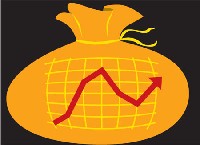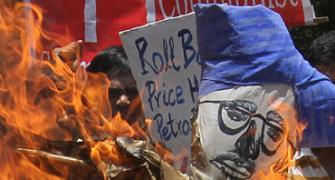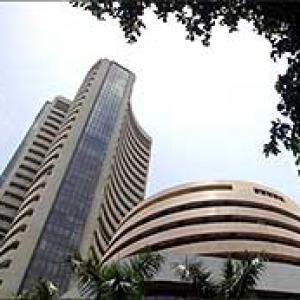If you can spare the time to watch only one financial variable, focus on interest rates. Rate changes have instantaneous effects on financial assets and time-lagged but powerful effects across the entire economy. Rising rates usually have a negative impact. Equity declines in value, debt assets decline in value, real estate drops in value. Other businesses are also hit.
Rising rates usually have a negative impact. Equity declines in value, debt assets decline in value, real estate drops in value. Other businesses are also hit.
If there's enough growth momentum, there may be capital appreciation despite rising rates. But at some point in every economic cycle, rates will rise when growth isn't strong enough to balance off.
The Indian economy is in that "sour spot" right now. There could be a quick turnaround if somehow, inflation dropped dramatically.
There could also be a floor on asset value if the FIIs pumped in funds as they did through most of 2010. But the FIIs have been consistent and heavy sellers through the last month. If we have to wait for the cycle to turn naturally without external fund flows, that could take considerable time.
Another source of concern is political instability. The scams uncovered in 2010 have obvious political repercussions. There are critical assembly elections around the corner and adverse results could further destabilise the UPA. Even a fear of political instability leads to lower investments in crony capitalistic environments like India.
So there's a mix of inflation, investment cutback and fears of political instability. How long this situation can last and what damage can it do?
Look at the historic pattern of Indian cycles. Inflation always peaks in the teens and tends to stays above double-digits for long periods - at least six months.
Indian bear markets also tend to 30-50 per cent corrections from peak values of the previous bull market.
By that logic, rates should peak at 13 per cent plus (up another 400 basis points) and stay at those levels for at least two quarters. The Nifty could fall to the 4500-mark or lower.
In terms of time, we could see the sour spot affecting asset values till late 2011-12 or early 2012-13. This seems a gloomy prognosis and I'd be happy to be wrong. But it's a high probability scenario.
If you are going to invest in Indian assets, you must face the potential downside fair and square.
Let's discuss some strategies that mix and match the need to preserve capital in a bearish market with the desire to hold cheaper long-term assets and the hope of generating capital appreciation.
If you want to just preserve capital, rollover cash surplus in short-term fixed deposits. The opportunity cost in short-term deposits is lower.
If interest rates are hiked, you can rollover to the higher rates within 2-3 weeks. If you choose this strategy, you must wait until equity indices hit valuations you find attractive.
One way to seek short-term returns is of course, to ride the trend South by shorting judiciously. That is not a game most investors are happy to play.
If you seek short-term capital appreciation and you don't want to short, examine agro and energy plays.
Despite the obvious policy risks caused by kneejerk responses to inflation, there may be counter-cyclical possibilities. After all, these commodities are causing much of the inflation.
Apart from playing the commodity futures exchange, there are listed stocks. A basket with a higher weight of assets in tea, coffee, sugar, petro-products and natural gas could outperform.
Since renewables also respond positively to high crude prices, there may be a revival in wind power and in solar. Certainly there are plenty of ambitious projects being announced in those spaces though financial closure will be a stumbling block for some of them.
What signals should a pragmatic, value-conscious investor look for before becoming interested in broad-spectrum equity investments again?
The time factor cannot be calculated. Recessions and bear markets can vary a lot in length and magnitude. However the next bull market whenever it comes along, will by definition, see indices rising to at least the 2010 peak levels (Nifty 6300+).
So at Nifty 5000 or below, (a correction of 1300-1400 points from the 2010 peak), broadly diversified equity will be a safe long-term investment again. At Nifty 4500 or lower, the stock market would be very attractive.
Equity could fall quite a lot further than that, but as and when, corrections hit those levels, a long-term investor could stop simply preserving capital and start re-investing. An alternative buy signal would be a change in the trend of rising interest rates.








